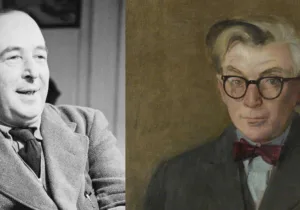This movie review of Dunkirk—which will be released in time for Christmas on Digital HD next Tuesday, December 12, and on 4K, Blu-ray, and DVD on December 19—first appeared in the Summer 2017 issue of Providence’s print edition. To read the original review in a PDF format, click here. To receive future issues as soon as they are published, subscribe for only $28 a year. Marc LiVecche also recorded a podcast reviewing Dunkirk with naval historian Thomas Sheppard and Providence deputy editor Mark Melton, which can be listened to either on our website, iTunes, or SoundCloud.
The historic event grounding Christopher Nolan’s Dunkirk involved a military crisis that was, in its beginning, as dark, desperate, and seemingly hopeless as it was extraordinary, full of heroism, and even miraculous in its conclusion. Whether his film captures any of that sufficiently is an open question.
On the 10th of May 1940, blitzkrieg kicked its way the global lexicon as German parachutists, infantry, and armor punched through the Low Countries of the Netherlands, Luxemburg, and Belgium. Five days later, they broke through French defenses and swarmed into the country, and outpacing and overwhelming any hope for an effective counter-offensive. Quickly reaching the northwest coast of France, the German spearhead severed the British Expeditionary Force (BEF), the French First Army, and the Belgian Army from the majority of the French troops to the south of the German line. Beginning to sweep north, the German penetration was poised to capture the remaining French ports and to trap the seemingly surrounded British and French troops.
But they were not, of course, surrounded. Yes, on all land-sides they had the Germans and to their backs they had the sea, but they had the sea. And out of this sea would come a miracle of deliverance. Who better than Winston Churchill to deliver the narrative?
The Royal Navy, with the willing help of countless merchant seamen, strained every nerve to embark the British and Allied troops; 220 light warships and 650 other vessels were engaged. They had to operate upon the difficult coast, often in adverse weather, under an almost ceaseless hail of bombs and an increasing concentration of artillery fire. Nor were the seas…themselves free from mines and torpedoes. It was in conditions such as these that our men carried on, with little or no rest, for days and nights on end, making trip after trip across the dangerous waters, bringing with them always men whom they had rescued. The numbers they have brought back are the measure of their devotion and their courage.
In this July 4th speech to the House of Commons, Churchill admitted that a week earlier he feared that his next statement to the House would be to announce the “greatest military disaster” in his nation’s history. When the crisis at Dunkirk first began, Churchill didn’t dare hope that any more than 20,000 or 30,000 troops might successfully be re-embarked. In the end, almost 340,000 troops made it home. As he alluded, the “difficult coast” of Dunkirk was a singularly poor place to attempt any such evacuation. Among the primary challenges was the absence of a deep-water port. Extremely shallow, the beach gently shelved a good distance from the waterline. Those ships capable of taking aboard large numbers of evacuees, including commercial ferries and naval destroyers, were necessarily deep-drafted, requiring upwards of 15 feet to float. Hence the need for those 650 “other vessels”—“small boats” as they’d affectionately come to be known—able to ferry men from shore to the larger ships at deeper anchorage. As the film’s tagline insists, home came for those who couldn’t get home.
Churchill’s oratorical gaze spanned the domains of battle, lifting from sea to sky. He stressed the role of the Royal Air Force, whose contributions over the course of the rescue were often unseen by those on the beach and water, leading many to “underrate its achievements.” Not so, said Churchill: the miracle at Dunkirk “was gained by the air force.” In every dimension, he insisted, Dunkirk was “a miracle of deliverance, achieved by valor, by perseverance, by perfect discipline, by faultless service, by resource, by skill, by unconquerable fidelity.”
It is in comparison to the incandescence of history’s Dunkirk that Nolan’s Dunkirk falls short. A common complaint about the film points not to an oversight but to something surely intentional. Many viewers insist the film’s characters are, every one, grossly underdeveloped. There’s no backstory, nothing really to even mark them as individuals. In fact, at the risk of being outed as some kind of Anglo-racist, I confess that all the English troops simply looked alike to me, I couldn’t tell them apart.
In much the same way, while the identity of the eponymous battle being depicted is clear, Dunkirk seems insistent that one not focus exclusively on Dunkirk. In terms of adversary, I don’t think we ever hear the word “German.” We certainly never see them—except in warplanes and, briefly, at the very end when they apprehend a downed RAF pilot—though even then they are gauzy forms outside the depth of field. We get, instead, only the generic locution “enemy.” Yes, yes, Dunkirk is what’s obviously unfolding onscreen—but, really, especially in light of what seem certain continuity problems (is that modern Dunkirk steaming beneath the descending Spitfire in the end?) and certain factual inaccuracies (I can find no record of small boats evacuating from Dunkirk going past the Cliffs of Dorset) Nolan seems to suggest all this could be about any threat, any enemy. This has led some reviewers to see the film as equally about the historic evacuation as it is about Islamicist terror or even Brexit.
So I’m left to assume that Nolan wasn’t specifically concerned about the particular Englishmen around whom the film is ostensibly centered. Rather, his concern was the types: the foot soldier, the pilot, the civilian sailor. Indeed, the main character, if there is one, is a British soldier named Tommy, which is both a name and a generic term for, well, a British soldier.
But why? If not about Dunkirk or particular men involved with the evacuation, what is Dunkirk about? An interpretive key can be found in what appears to be a framing device, found at the beginning and the end of the film, that offers contrasting comments on the notion of “survival.”
In the opening scene, Tommy is moving through the town of Dunkirk toward the evacuation beach. He catches a propaganda leaflet dropped from an enemy plane and featuring a map of the besieged BEF position. In the bottom margin is a warning “We surround you! Surrender [and] survive!”
Fast forward to the conclusion. Tommy safely aboard a London-bound train and reads aloud an excerpt from Churchill’s House of Commons speech. He delivers the final lines of the peroration, “We shall fight on the beaches, we shall fight on the landing grounds, we shall fight in the fields and in the streets, we shall fight in the hills; we shall never surrender.” In classic rhetoric, the peroration is the summary conclusion of a speech typically delivered at a higher emotional pitch. Through it, one can find the meaning of the preceding text.
I need to retract, somewhat, my earlier suggestion that none of the characters are developed. There is a modest exception. Mr. Dawson (Mark Rylance), the owner of a small pleasure boat who pilots it to Dunkirk, is the film’s moral core. About him we know little, save that he’s already lost a son in the RAF. He saves a shipwrecked soldier from the water who pleads for the boat to head immediately back to England. Mr. Dawson will have none of it. He says simply, “There’s no avoiding this, son; we have a job to do.”
Seen through Churchill’s peroration, Mr. Dawson’s admonition suggests that the theme of Dunkirk is, quite simply, that modest, obstinate, British determination to carry on—a phrase that appears more than once in Churchill’s speech. In fact, just before Tommy reads Churchill’s words, there is an exchange between another British tommy and an old man handing out blankets.
“All we did was survive,” the tommy complains.
“Sometimes,” says the old man, “That’s enough.”
In between these framing moments, Dunkirk shows us men trying to survive. At times, it isn’t pretty. We see cowardice, deception, opportunism, panic, men abandoning other men to face their fate alone. But we also see heroism, self-sacrifice, and mutuality—men (and women) at their best. Most times, we see men who will do much—but not everything—to live. On the one hand, the Germans offer survival at the cost of subjugation. On the other, Churchill calls a nation to survival for the purpose of being able to fight another day:
I have, myself, full confidence that if all do their duty, if nothing is neglected, and if the best arrangements are made, as they are being made, we shall prove ourselves once again able to defend our Island home, to ride out the storm of war, and to outlive the menace of tyranny.
That the British did, in fact, survive, that their unwillingness to bow their knees to totalitarianism did, in fact, help led to the final liberation of Europe, is a testament to the power of simply carrying on, one steady step at a time.
Of course, it ought not to have been this way. Churchill is the first to point out that wars are not won by evacuations. Among the takeaways for any modern viewer is the simple fact that, in war especially, defeat sucks. The British lost 30,000 men in the days leading up to Dunkirk. They lost near-crippling resources in military armaments and other material. Total defeat was always a possibility.
The military disaster of Dunkirk reminds us that the time to prepare for war is not the moment before you learn what blitzkrieg is. We must have the men and equipment necessary, in times of deepest peace, to be ready to fight and win the next conflict. More than this, a portion of the just war commitment to “last resort” includes not presenting an inviting target to those adversarial nations with malevolent intent. A strong and ready military helps prevent conflict by presenting a deterrent—nations that know they will bleed if they pick a fight with us might, in the end, not pick a fight with us or with those friendly nations whose interests we might protect.
Finally, Dunkirk reminds us of the necessary spirit of co-belligerence that ought to exist in a free nation between the professional military and the civilian population. Binding these two spheres together is an implicit contract that each will care for the other. The military has our six, we must have their backs. That may mean that journals like this exist to help provide the moral intelligence necessary to help warfighters know their duty or to navigate the morally bruising theatre of combat without becoming morally injured. It may mean providing deployed warfighters stable communities worth their coming home to—places in which they can reintegrate, tell their stories, be heard, be taken seriously, be commended, be thanked, and to which they can contribute.
At its best, Dunkirk captures a bit of all of these most Dunkirkian of sentiments. But too seldom. The story of Dunkirk is a story very much worth telling. But Dunkirk doesn’t quite manage to tell it. As a film, it doesn’t flourish—it merely survives.
—
Marc LiVecche (PhD, University of Chicago) is managing editor of Providence.
Photo Credit: Warner Bros. Entertainment Inc.







 Sponsor a student for Christianity & National Security 2024
Sponsor a student for Christianity & National Security 2024